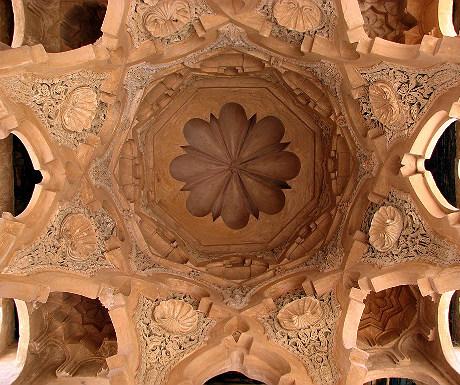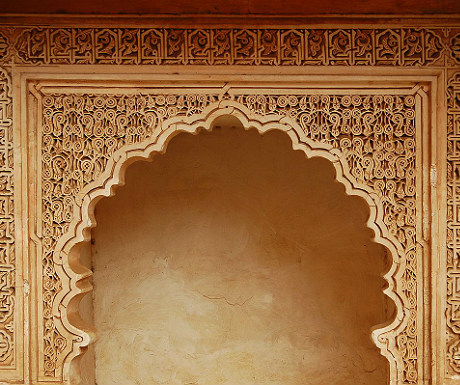Africa · Attractions · Going Out · Morocco · Regions
5 monuments not to miss in the medina of Marrakech
With centuries of history and architectural wonders, the medina is a treasure trove of antiquities that take visitors through the long history of the citys past rulers. Travel back hundreds of years into the past to discover unique examples of architectural styles, or marvel at the regal beauty of private royal quarters. Here are five of the most magnificent monuments to explore in the medina:
Ben Youssef Madrasa
Over four centuries old, this celebrated site encapsulates Marrakechs place in history as a prominent centre of learning and knowledge. The Ben Youssef Madrasa was built in the fourteenth century, and throughout its lifetime, attracted thousands of students from across the world, drawn both to the city and the Madrasas renowned reputation as a hub for research and understanding into the foremost contemporary sciences. After construction of the school was given a transformation by the citys Saadian rulers in the 1570s, the Madrasa was given the distinctive architectural style that makes it such a stunning historic site to visitors today. while it is no longer active as a school, its still possible to explore the tiny dormitories that hundreds of students would have once called their home, as well as admiring the distinctive Arabic inscriptions made in stucco and zellij tiling, or to simply relax in the calm tranquility of the open courtyard at the heart of the building.
Bahia Palace
The extravagant and opulent surroundings of the Bahia Palace give visitors to the medina a chance to step back in time, and immerse themselves in a taste of old world luxury and glamour. Bahia Palace, translated literally as brilliance was constructed in the 19th century, and intended to be the greatest palace of all time. With 160 rooms, each crafted in minutely dedicated detail, the palace retains much of its stunning charm and splendour. While it is still used by the royal family, and closed during their visits, during other times the Bahia Palace is a popular destination for history buffs and architecture lovers alike, who can explore intricately decorated courtyards, marvel at the cedar carved ceilings and admire the beautiful tile work that captures the essence of oriental style.
Qoubba Almoravides
First glances can be deceptive, and the Qoubba Almoravides may appear unassuming and uninspiring to the casual passer by. But as the oldest building in Marrakech, dating back to the 12th century, the monument is a truly unmissable gem of architecture. The small, two-storey construction was originally built as an outbuilding of the larger Ben Youssef mosque, as a place for ritual ablutions for visitors. As the last remaining example of the Almoravid architectural style in Morocco, it provides a unique insight into how the mosque may once have appeared, before its reconstructions, as well leaving the city with an invaluable architectural legacy. With richly decorated interiors, including carvings, calligraphy and marble-set inscription, it remains an understated but stunning historical gem.
 Saadian Tombs
Dating back to the sixteenth century, the Saadian Tombs are an extraordinary monument to the Saadi Dynasty, comprising of three rooms homing the royal family. During the time of their construction, its clear that no expensive was spared, and imported Italian marble and elaborately gilded plasterwork in gold give a taste of the original regal splendor of the tombs. While they lay forgotten in history for several centuries, the tombs were re-discovered at the start of the twentieth century, and guests can now explore the tombs and surrounding garden compounds, as well as the secret passages hidden within.
Saadian Tombs
Dating back to the sixteenth century, the Saadian Tombs are an extraordinary monument to the Saadi Dynasty, comprising of three rooms homing the royal family. During the time of their construction, its clear that no expensive was spared, and imported Italian marble and elaborately gilded plasterwork in gold give a taste of the original regal splendor of the tombs. While they lay forgotten in history for several centuries, the tombs were re-discovered at the start of the twentieth century, and guests can now explore the tombs and surrounding garden compounds, as well as the secret passages hidden within.
 El Badi Palace
The 360 room El Badi Palace may be a shadow of its past splendour, but this magnificent historic construction still gives visitors a taste of Moroccos regal past. Once reportedly covered in gold, along with inlays of ruby and turquoise, the palace was originally built in the sixteenth century, over 25 years. Alongside its immense size, the spectacular views of the Atlas mountains from the terraces give a breathtaking experience, while more adventurous visitors can also explore the serpentine underground tunnels that once held the Kings prisoners.
Stéphane Abtan is Director at Dar Ayniwen.
El Badi Palace
The 360 room El Badi Palace may be a shadow of its past splendour, but this magnificent historic construction still gives visitors a taste of Moroccos regal past. Once reportedly covered in gold, along with inlays of ruby and turquoise, the palace was originally built in the sixteenth century, over 25 years. Alongside its immense size, the spectacular views of the Atlas mountains from the terraces give a breathtaking experience, while more adventurous visitors can also explore the serpentine underground tunnels that once held the Kings prisoners.
Stéphane Abtan is Director at Dar Ayniwen.
 Saadian Tombs
Dating back to the sixteenth century, the Saadian Tombs are an extraordinary monument to the Saadi Dynasty, comprising of three rooms homing the royal family. During the time of their construction, its clear that no expensive was spared, and imported Italian marble and elaborately gilded plasterwork in gold give a taste of the original regal splendor of the tombs. While they lay forgotten in history for several centuries, the tombs were re-discovered at the start of the twentieth century, and guests can now explore the tombs and surrounding garden compounds, as well as the secret passages hidden within.
Saadian Tombs
Dating back to the sixteenth century, the Saadian Tombs are an extraordinary monument to the Saadi Dynasty, comprising of three rooms homing the royal family. During the time of their construction, its clear that no expensive was spared, and imported Italian marble and elaborately gilded plasterwork in gold give a taste of the original regal splendor of the tombs. While they lay forgotten in history for several centuries, the tombs were re-discovered at the start of the twentieth century, and guests can now explore the tombs and surrounding garden compounds, as well as the secret passages hidden within.
 El Badi Palace
The 360 room El Badi Palace may be a shadow of its past splendour, but this magnificent historic construction still gives visitors a taste of Moroccos regal past. Once reportedly covered in gold, along with inlays of ruby and turquoise, the palace was originally built in the sixteenth century, over 25 years. Alongside its immense size, the spectacular views of the Atlas mountains from the terraces give a breathtaking experience, while more adventurous visitors can also explore the serpentine underground tunnels that once held the Kings prisoners.
Stéphane Abtan is Director at Dar Ayniwen.
El Badi Palace
The 360 room El Badi Palace may be a shadow of its past splendour, but this magnificent historic construction still gives visitors a taste of Moroccos regal past. Once reportedly covered in gold, along with inlays of ruby and turquoise, the palace was originally built in the sixteenth century, over 25 years. Alongside its immense size, the spectacular views of the Atlas mountains from the terraces give a breathtaking experience, while more adventurous visitors can also explore the serpentine underground tunnels that once held the Kings prisoners.
Stéphane Abtan is Director at Dar Ayniwen.Did you enjoy this article?
Receive similar content direct to your inbox.

